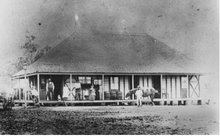Wilhelm Beutel was born in Schmolln, Prussia in 1840. In November 1865 he married Wilhelmine Friederike Louise Maas, a fellow Prussian, born at Frauenagen in 1843. The marriage was fruitful and produced seven children. On December 17, 1880, the family of seven (two of the children had died young) boarded the Earl Granville in Plymouth, England headed for Australia. Their children were 14, 12, 10, 8 and 2. Another child was born on the way. The Earl Granville sailed around the South coast of Australia, and up the east coast to Rockhampton, her first port of call in 109 days. After ten days of quarantine restrictions 276 passengers disembarked at Rockhampton.
By May 16, 1881 two of their children, Gustav and Anna were enrolled at Beenleigh State School. Records show their father was a farmer and their residence was in Beenleigh. By February 1882, the family had moved to Tallegalla and little Anna was enrolled at the Tallegalla State School. In May 1883, Wilhelm was naturalised at Millbong, in the Fassifern region. The family stayed at Millbong until the death of Wilhelmine in 1889 (aged only 46). Wilhelm married a widow with four children and died in 1892, leaving his wife widowed for a second time. Do you think she considered herself unlucky?
The Beutel’s story is interesting in both a general and a specific way. First, it shows how migrants moved around on arrival until they found a place to settle. Can you imagine how hard it would have been to arrive in a totally new country and to select land? Good land was heavily competed for. There are many tales of people applying for land grants and losing the ballot. Sometimes people arrived at their selection to find that it was impossible to farm. Other times, they simply heard of better options. As they become accustomed to the country and to farming, since not all of them were farmers in Germany, they were able to better choose land.
The Beutels illustrate the historical reasons for having large families. While Wilhelm and Wilhelmine did not live long after their arrival in Australia, their large family spread and prospered. Southeast Queensland is still home to many Beutels.
My specific interest in the Beutels is that they are listed as the original holders of our land. While we only have a few acres divided off from the original lot as a family subdivision in the 1950s, the original lot was the 40 acres provided to an adult migrant. I can imagine the nine year old Anna walking up Two Tree Hill and along the ridge to the Tallegalla School. It would have been quite a hike by our standards. I wonder if she ever rode or perhaps Wilhelm or one of her brothers would ride with her to school.
In the Beutel family history there is a photograph of Anna dressed in formal attire. I look at her in her heavy black clothing and compare her with my children. There is something similar in her wide-eyed serious gaze. I imagine though that life for Anna would have been much more serious than for my children. I look at her clothes and on a 35C day try to imagine dressing like that for any period of time. I try to imagine getting my children to dress like that and fail. It’s an invaluable visual aid in trying to picture the Jaeckels on arrival in Australia.
Tuesday 9 October 2007
Wilhelm und Wilhelmine
Labels:
Australia,
German migrants,
history,
Jaeckels,
land grants,
Queensland,
Tallegalla
Subscribe to:
Post Comments (Atom)

1 comment:
Fascinating story, or skeleton of several life stories. The widow, left with 6 step-children and 4 of her own, can't have been an unusual situation, and makes the fairy tale stepmothers of Snow White and Cinderella a little more understandable -- or perhaps "normal" is a better word. Like the different expectations about clothing, there must have been a different attitude towards death among our ancestors, too. It was so much more a part of daily life.
What did it mean to become naturalised? Was it something only men could do (because you don't mention Wilhelmine)? Would this have affected the citizenship status of the children or his wife (if he had pre-deceased her)?
None of these are questions that necessarily would apply to the Jaeckels, of course.
Post a Comment